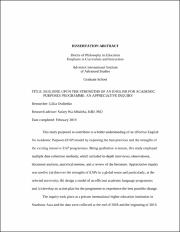| dc.description.abstract | This study purposed to contribute to a better understanding of an effective English for Academic Purposes (EAP) model by exploring the best practices and the strengths of the existing intensive EAP programmes. Being qualitative in nature, this study employed multiple data collection methods, which included in-depth interviews, observations, document analysis, analytical memos, and a review of the literature. Appreciative inquiry was used to (a) discover the strengths of EAPs in a global sense and particularly, at the selected university; (b) design a model of an efficient academic language programme; and (c) develop an action plan for the programme to experience the best possible change.
The inquiry took place at a private international higher education institution in Southeast Asia and the data were collected at the end of 2018 and the beginning of 2019.
Maximum variation purposive sampling helped select the cases that reflected heterogeneity in terms of cultural and linguistic backgrounds, the degree and the programme sought, and the current status regarding EAP. Seventeen participants made up the sample of this study.
Five research questions aligned to the 5D cycle of Appreciative Inquiry guided this study. The data were coded and classified into 44 categories and 15 themes. These themes, in turn, led to the four overarching pillars of an effective EAP programme: (a) connected curriculum, (b) connected instructional practices, (c) connected learning environment, and (d) connected spirituality.
The findings proposed clear guidelines for the EAP model that represents the integration and interrelation of the four themes, which resulted in the emergence of a connectedness model of EAP. Most studies in the modern EAP literature tend to discuss EAP curriculum, pedagogy, and learning environment as separate units. However, this model encourages the development and promotion of best practices by creating alignment between and within curriculum design, instructional practices, a supportive learning environment, and a spiritually-enriching context. | en_US |

